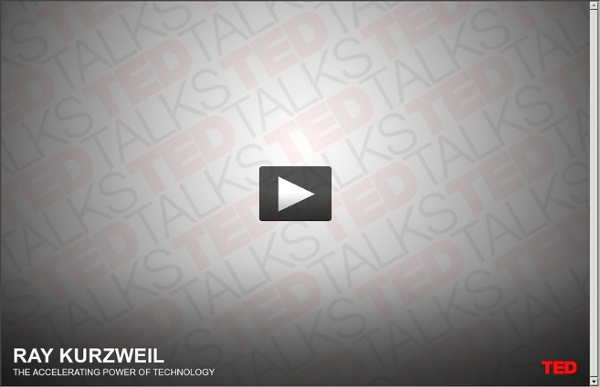



http://www.ted.com/talks/ray_kurzweil_on_how_technology_will_transform_us.html
Related: TranshumanismRe-Evolving Mind, Hans Moravec, December 2000 Computers have permeated everyday life and are worming their way into our gadgets, dwellings, clothes, even bodies. But if pervasive computing soon automates most of our informational needs, it will leave untouched a vaster number of essential physical tasks. Construction, protection, repair, cleaning, transport and so forth will remain in human hands. The Singularity Is Near The Singularity Is Near: When Humans Transcend Biology is a 2005 non-fiction book about artificial intelligence and the future of humanity by inventor and futurist Ray Kurzweil. This is his first book to embrace the Singularity as a term, but the ideas contained within are derived from his previous books, the The Age of Spiritual Machines (1999) and The Age of Intelligent Machines (1990). Kurzweil describes his law of accelerating returns which predicts an exponential increase in technologies like computers, genetics, nanotechnology, robotics and artificial intelligence.
How Self-Replicating Spacecraft Could Take Over the Galaxy I'm going to re-post here a previous comment I made on this subject, because I think it's worth repeating. Any alien civilization that is sufficiently developed enough to span the cosmos, will be so far advanced from us, that we would not be able to even comprehend their technology and in turn they probably wouldn't even recognise us as a sentient intelligent species. I've always found the "Well if there are aliens why haven't they said hello?" argument to be far too arrogant. SIN Graph - Countdown to SIN Logarithmic Chart Countdown to Singularity, Events expressed as Time before Present (Years) on the X axis and Time to Next Event (Years) on the Y axis, Logarithmic Plot Page 17, Linear Plot page 18. Source: M.T. Rosing, "13C-Depleted carbon microparticles in >3700-Ma sea-floor sedimentary rocks from west greenland," Science 283.5402 (January 29, 1999): 674-6, See also H. Furnes et al., "Early life recorded in archean pillow lavas," Science 304.5670 (April 23, 2004):578-81; M.T. Rosing, "Early Archaean oxygenic photosynthesis - The observational approach," Geophysical Research Abstracts 7.11202 (2005); W. Altermann and J.
How to build a Dyson sphere in five (relatively) easy steps If you have energy, you can launch as much mass as you want into space. If you have enough mass, you have a radiation shield, and with the energy from your swarm, you can spin that mass for gravity. These are not issues. Well we could live on Earth and just keep the dyson swarm inside the orbit of Mercury. Moore's law Moore's law is the observation that, over the history of computing hardware, the number of transistors on integrated circuits doubles approximately every two years. The law is named after Intel co-founder Gordon E. Moore, who described the trend in his 1965 paper.[1][2][3] His prediction has proven to be accurate, in part because the law is now used in the semiconductor industry to guide long-term planning and to set targets for research and development.[4] The capabilities of many digital electronic devices are strongly linked to Moore's law: processing speed, memory capacity, sensors and even the number and size of pixels in digital cameras.[5] All of these are improving at roughly exponential rates as well. This exponential improvement has dramatically enhanced the impact of digital electronics in nearly every segment of the world economy.[6] Moore's law describes a driving force of technological and social change in the late 20th and early 21st centuries.[7][8] History[edit]
Answering the Fermi Paradox: Exploring the Mechanisms of Universal Transcension, John Smart, 2002-2010 Answering the Fermi Paradox: Exploring the Mechanisms of Universal Transcension © 2002-2011, John M. Smart. Reproduction, review and critique encouraged with attribution. Permalink: First published as Smart, J.M. 2002. Answering the Fermi Paradox.
Technological Singularity The technological singularity is the hypothesis that accelerating progress in technologies will cause a runaway effect wherein artificial intelligence will exceed human intellectual capacity and control, thus radically changing civilization in an event called the singularity.[1] Because the capabilities of such an intelligence may be impossible for a human to comprehend, the technological singularity is an occurrence beyond which events may become unpredictable, unfavorable, or even unfathomable.[2] The first use of the term "singularity" in this context was by mathematician John von Neumann. Proponents of the singularity typically postulate an "intelligence explosion",[5][6] where superintelligences design successive generations of increasingly powerful minds, that might occur very quickly and might not stop until the agent's cognitive abilities greatly surpass that of any human. Basic concepts